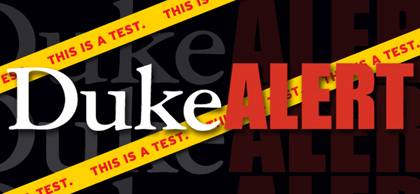All Systems Go During DukeALERT Test
University well prepared to communicate quickly when needed

Speed counts in an emergency - and the results from the most recent test of Duke's emergency notification system indicate the university is well prepared to communicate quickly when needed.During the April 21 test, Duke pumped out nearly 65,593 email messages to all students, faculty and staff in about four minutes. Based on results of an online survey conducted as part of the test, email remains the most effective method of notification, reaching 87 percent of nearly 2,500 individuals who completed the survey. However, text messaging is quickly moving up the list. The number of people receiving an emergency text message increased significantly since the test last fall. This was due largely to the required inclusion of all student mobile phone numbers and all Duke-purchased cell phones earlier this year. During the DukeALERT test in the fall semester, only 6,146 individuals received a text message, compared with nearly 22,700 during the April 21 test. Text messaging ranked second among the most effective notification tools in the survey, with 55 percent of respondents indicating they received a text message. Despite the increase in volume, the messages were still delivered efficiently to cell phone vendors such as AT&T and Verizon, with 98 percent of messages reaching vendors within minutes. "Text messaging is becoming increasingly important with the mobile nature of our students, faculty and staff," said Kyle Cavanaugh, Duke's emergency coordinator and vice president for Human Resources. "Emergencies don't coordinate with our schedules, so people may not be sitting in front of a computer when something happens. But today, more people are walking around with cell phones, which allows us to get information into the hands of those who need it." The web metrics for the DukeALERT website reflect the increasing use of mobile devices at Duke. About 16 percent of the 3,500 unique visits to the site on April 21 were from a mobile device such as BlackBerry, iPhone and Android phone. "We continue to enhance our technology or expand its reach," Cavanaugh said. "It is important for us to test the technology, but the repetition of the test each semester also helps people understand how they will be notified in the event of an actual emergency."